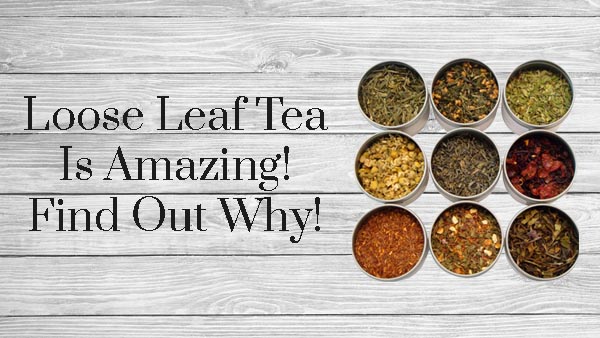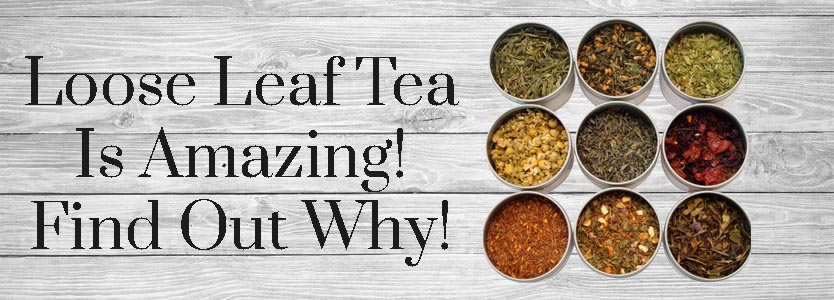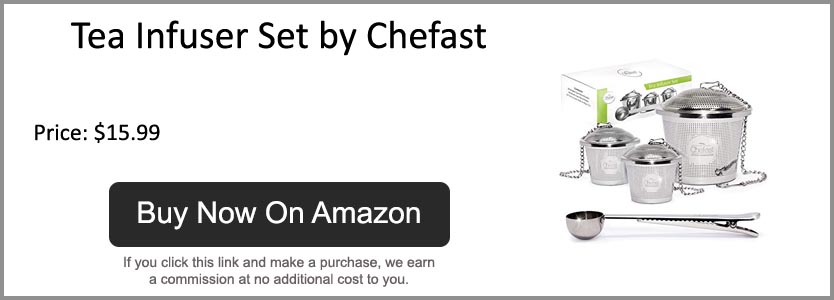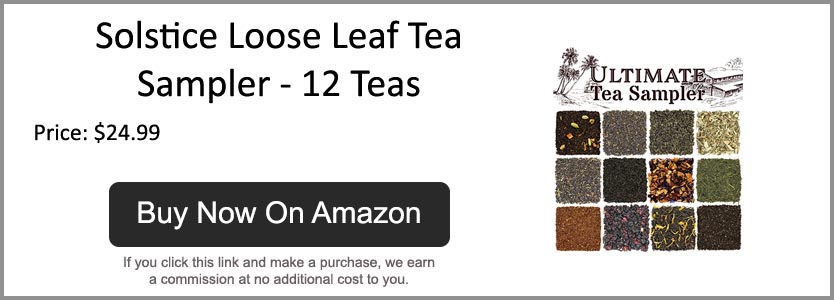Tea has amazing benefits for your mental and physical health. But you may not have thought much about the differences between loose tea and the tea bags at your local grocery store. By the time you’re done reading this article you may want to ditch the traditional tea bags and incorporate loose leaf tea into your routine.
As a personal side note, my work has me traveling internationally to places like India and China. Both countries serve their teas as loose leaf tea. I find that their teas are definitely more flavorful and delicious. Especially, in China where their is a very large tea culture. Drinking traditional Chinese tea following their rituals is quite an event to experience.
Why Loose Tea Is The Best!
First Let’s Look At Tea Bags
Lower Quality Tea
Before we get into the best loose leaf tea let’s first understand some things about tea bags. The leaves used in most bags are actually the “dust and fannings” from broken tea leaves. Dust and fannings tend to be the left overs from tea production. Bagged teas also often include stems and seeds that can make the tea taste bitter. This creates a huge compromise in quality from full loose leaf tea.
Loss Of Flavor And Aroma
Most of the essential oils and aroma are stripped away because the tea leaves are finely broken. When steeped, they release more tannins than whole leaf tea which results in bitter tea. Most tea bags constrain the tea leaves, keeping them from expanding to their full flavor and aroma potential. Another important factor is the tea bags themselves. The material, size, and shape of the bag also contributes to the brewing tea. Often, tea is bagged in a bleached paper material that can add chemicals and off flavors to tea.
Problems With Tea Bags
The demand for standardized flavor has caused manufacturers to make a tea bag with blended teas. If you buy tea from a grocery store you’ll probably notice that the tea tastes the same every time. This is because the bag is blended with teas from around the world. Each year the quantities of teas from certain locations will vary based on price and the final flavor profile the blenders are trying to attain. Often, a higher premium is placed on a tea’s price and standardization than on its quality and character of flavor profile. So even though your tea might taste the same each time the origin of the teas may not be the same.
Now Let’s Look At Loose Leaf Tea
Artisanal Choice Of Flavors And Aromas From Loose Tea
With loose leaf tea, the tea is out of the bag. This means you can make sure you’re getting fresh tea that tastes great. To pick up where we left off with tea bags, loose tea may be a specialty tea from a single region or even a single portion of a single estate. Although your tea might be from the same estate the flavors, aromas, and appearance may vary from one purchase to another. The change may not be drastic but it could be noticeable. As loose tea is packaged in airtight containers the freshness and flavor are not lost as much as tea bags over time.
Now let’s get back to the tea leaves. Loose leaf teas are produced seasonally in small quantities. This makes for an artisanal tea that involves hand picking and hand sorting quality tea leaves. Because of the quality of the tea leaf the same leaves can be steeped multiple times for several cups of tea. The upfront cost of the tea might be more expensive, but since loose tea can be steeped multiple times it ends up being a cost savings.
As we mentioned with tea bags the tea leaves are constrained in the bag. With loose tea, subtle nuances and flavors are extracted from whole tea leaves that are allowed to expand fully in hot water. But with loose leaf tea you’re not just tied to what’s in the tea bag. Now you can also play a mixologist if you want to. You can add as much or as little tea as you want to your cup. Also, different tea blends can be created that you couldn’t find in any store. Endless flavors and aromas can be customized to the point where your senses will be dancing!
Best Loose Leaf Tea For Your Tastes and Health
Health Benefits of Loose Tea
Now that we’ve covered why loose tea is amazing let’s now go into some of the best loose leaf teas you can purchase. Loose leaf teas are packed with antioxidants and claim to provide a number of health benefits. Some of these benefits are to help decrease blood pressure, reduce the risk of cancer and aid in the reduction of weight loss. Loose tea is also said to have benefits for your skin and help reduce rinkles. LDL Cholesterol (the BAD cholesterol) may also be lowered.
Most people have heard about the health benefits of tea. Since the loose tea leaf maintains all of the natural elements the health benefits of loose leaf tea could be slightly increased over tea in tea bags.
Black Tea
Black tea is one of the most consumed beverages in the world which puts it atop the list of the best loose leaf tea. It comes from the Camellia sinensis plant and is often blended with other plants for different flavors, such as Earl Grey, English breakfast or chai. Black tea has more caffeine than other teas, but less caffeine than coffee. There are also a number of other health benefits because it contains antioxidants and compounds that can help reduce inflammation in the body. Within the group of antioxidants, called flavonoids, are antioxidants that contribute to better heart health.
Black tea is grown and processed all over the world in varying geographies and climates. Three of the largest producers of black tea are India, Sri Lanka and Africa. Even though most of us think about Chinese tea half of the world’s tea production actually comes from India. Some of the most popular styles of black tea coming out of these top-producing countries include:
-
Assam:
India’s Assam region is the largest tea-growing region in the world. The rainy, tropical climate produces a tea known for its bold and malty characteristics that stand up well to milk and sugar.
-
Ceylon:
Sri Lanka’s economy largely depends on its tea gardens. Sri Lanka has more than half a million acres of tea gardens which range in location from cool and mountainous to humid and tropical. Most of the exports from Sri Lanka is black tea, known as Ceylon. Ceylon teas can vary depending on where they grow, but they are generally known to be strong and brisk with a hint of spice. Sri Lanka also happens to be known for its cinnamon production.
-
Darjeeling:
Grown in a smaller, mountainous tea-producing region of India, Darjeeling is a softer, more herbaceous black tea that can change based on each season with the changing climate. Darjeeling is often used as the tea base for India’s popular spiced beverage, Chai.
-
Kenyan:
In the early 1990’s Kenya began producing black tea. Actually, they learned and became quite good really fast. Kenya now leads Africa and the industry in the CTC style of tea production, producing and exporting mostly black tea. Kenyan tea is known for its assertive, full-bodied style.
Green Tea
Green tea also comes from the plant Camellia Sinensis, but green tea come from a smaller shrub. The tea leaves are harvested from the and are quickly heated by pan firing or steaming. They’re then dried to prevent too much oxidation from occurring that would turn the green leaves brown and alter their fresh-picked flavor.
Green tea is generally known to have a lower caffeine content than black tea. This means that the caffeine content is much lower than coffee. However, like all drinks produced from caffeinated plants a specific level of caffeine is hard to determine since there is a lot of variation from one production region to another.
Green tea is arguably the healthiest beverage in the world. It’s loaded with antioxidants and nutrients that have powerful effects on the body. Also included in the health benefits are improved brain function, fat loss, a lower risk of cancer and many other impressive benefits. The antioxidants in green tea can also lower your risk of cancer.
Types Of Chinese Green Tea
-
Dragonwell:
A smooth, flat, sword-shaped appearance and pan-fired toasty taste give this tea its characteristic look and flavor no other green tea-producing region has been able to duplicate. It is considered a classic pan-fired Chinese green tea.
-
Gunpowder:
Fired in perforated metal tumbler that tosses the leaves around in a figure eight pattern Gunpowder tea takes is name from the pellet-like shape of the finished leaf.
Types Of Japanese Green Tea
-
Sencha:
Sencha makes up more than 80 percent of the tea produced in Japan and is the most popular tea drunk in households and restaurants throughout the country. It is made from tea leaves that are steamed then typically rolled into long, skinny strands.
-
Hojicha:
Sencha is roasted over high heat to produce Hojicha, a tea with a roasted, nutty flavor. The application of high heat also helps reduce the tea’s caffeine content.
-
Genmaicha:
A blend of Sencha and roasted and popped rice, Genmaicha is a toasty tasting treat that is a popular tea to serve with food.
-
Gyokoro:
The tea leaves are shaded during the last few weeks before plucking to intensify the color and flavor of the tea that will become Gyokoro. During processing, it is rolled into its characteristic thin needlelike shape. Gyokoro is considered to be Japan’s most treasured tea.
-
Matcha:
Shade-grown like Gyokoro, the tea leaves that make Matcha are ground into a powder instead of shaped and rolled. Matcha is key to Japanese tea ceremonies and has become a very popular ingredient for cooking.
White Tea
White tea comes from the same Camellia Sinensis plant as black tea and green tea. It’s harvested before the tea plant’s leaves open fully, when the young buds are still covered by fine white hairs, hence the name “white” tea. Since white tea is the least processed of the three teas (black, green, and white) it retains a high amount of antioxidants.
White tea is generally thought to be lower in caffeine than both green tea and black tea. The original Fujian white tea plant native to China has been shown to be lower in caffeine than other tea plants. But other varieties of tea plants around the world that are being cultivated for white tea may not be as low in caffeine. Some studies even show that certain white teas may contain as much or more caffeine as green or black teas, depending on where they were cultivated and how they were processed. Like he other teas we discussed the caffeine content will vary by region.
Since white tea originates from the same plant as black tea and green tea many of the health benefits are the same. However, added benefits may help with the onset of osteoporosis and help with wrinkles in your skin.
- Bai Hao Yin Zhen (Silver Needle):
A true Silver Needle comes from the Fujian province of China and is cultivated from the original varieties of China’s white tea plant. It’s made from large, full buds that are covered with white, downy hairs that give the tea the silver color it’s named for.
-
Bai Mudan (White Peony):
This newer variety of white tea is cultivated in China and other countries around the world. It can be cultivated from an original Chinese white tea bush or from another variety. It usually includes some buds blended with unfurled or barely opened young tea leaves.
-
Monkey Picked White Tea:
Rumored to once be harvested by Buddhist-trained monkeys from the highest wild tea tree tops in mountainous regions of China, “monkey-picked” is a term used today to denote a very high-quality Chinese tea made from the buds and young leaves of the tea plant.
-
Darjeeling White Tea:
This variety is not cultivated from the original Chinese white tea plant variety but from tea plants native to the Darjeeling region of India. The processing method is similar to the Fujian white teas, but the flavor profile tends to be much different.
Oolong Tea
A lesser-known type of tea, oolong tea is made from the leaves of the Camellia sinensis plant, the same plant used to make black and green tea. What differentiates oolong tea is how the loose tea leaf is processed. Unlike black tea, which is fully oxidized with deep black leaves, oolong tea is partially oxidized. (Green tea leaves are steamed or pan-fired during processing, which prevents them from oxidizing.)
The caffeine content of oolong tea generally falls somewhere between black tea and green tea. A lightly oxidized oolong may have lower caffeine levels (similar to a green tea) and a highly oxidized oolong may have higher caffeine levels (similar to a black tea). Again, the caffeine content will depend on the region grown and how it was cultivated.
Besides the caffeine in oolong tea an amino acid is also found to promote relaxation. It’s said that sipping oolong tea may offer benefits for heart health, diabetes prevention, bone health, and weight loss, possibly due to the antioxidants thearubigins, theaflavins, and EGCG.
Chai Tea
At it’s core, chai tea is made from black tea leaves. We mentioned earlier that chai tea actually has an origin in India. What makes chai tea different is that spices are added to the tea. So a chai tea is not a loose tea leaf. Spices such as cinnamon, cardamom, cloves, ginger and black peppercorns are added to the tea. The spiced tea mixture is typically brewed strong with milk and sweetened with sugar or honey. However, the milky sweet tea treat we order in coffee and tea shops today has very little in common with the origins of Indian chai.
Chai Tea contains black tea so the caffeine content is similar to Teatulia Black Tea. This means that it contains about half the caffeine of a cup of coffee. As you know, caffeine content may vary depending on the region and how the tea was cultivated.
Last Thoughts On Loose Leaf Tea
Loose leaf tea is the most popular beverage in the world behind water. With some amazing health benefits you’re also getting a very flavorful drink. Drinking loose tea rather than buying tea bags will only increase flavor and the benefits that come with tea. This includes the taste. Lastly, you’ll get to experience some flavors that are truly global. Now you can have a taste of Africa, Sri Lanka, or China in your home.
Tea is an important part of many cultures around the world. Loose tea is served with almost every meal which makes it a part of every day life. One can argue that loose leaf tea is a major factor in increased health of other countries around the world.




